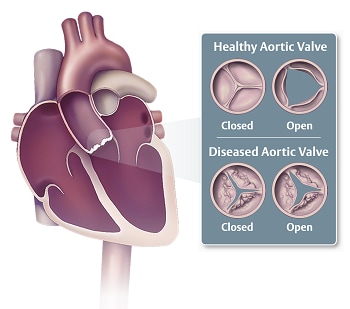Aortic Stenosis
 Your heart works hard every second of every day, pumping blood through your body. The four valves it contains play a huge role in that process.
Your heart works hard every second of every day, pumping blood through your body. The four valves it contains play a huge role in that process.
One of those valves is the aortic valve. It has thin leaflets that open and close when your heart beats to regulate blood flow.
Aortic stenosis happens when leaflets become stiff, narrowing the opening of the valve and making it harder for your heart to pump blood.
This condition can affect your health and gets worse over time. Your doctor will measure your aortic stenosis and determine if your case is mild, moderate or severe.
If mild or moderate, the decrease in blood flow usually won’t cause symptoms. Many people don’t know they have the condition or might have been told they have a heart murmur during a routine checkup.
 As the leaflets become stiffer, the opening of the valve becomes narrower and your heart muscle can get weaker. If your stenosis becomes severe, you may experience:
As the leaflets become stiffer, the opening of the valve becomes narrower and your heart muscle can get weaker. If your stenosis becomes severe, you may experience:
- Shortness of breath
- Fatigue
- Swollen feet and ankles
- Signs of heart failure
- Dizziness/lightheadedness
- Loss of consciousness
- Chest pain
People often say it’s harder for them to do normal activities, such as walk to the mailbox, go up stairs or do household chores. It’s important to tell your doctor if you have these symptoms. Those with severe aortic stenosis have a survival rate as low as 50% at two years and 20% at five years if they don’t have an aortic valve replacement.
Common Causes
Aortic stenosis has four main causes:
- Calcium buildup: As we age, calcium, a mineral found in our blood, can build up.
- Birth defects: A normal aortic valve contains three leaflets. Some people are born with more or fewer, causing the aortic valve to leak.
- Rheumatic fever: Strep throat can lead to rheumatic fever. This can cause scar tissue to form in your heart. When this happens, the valve may not be able to open and close as it should.
- Radiation therapy: Swelling and scar tissue can develop after radiation therapy, making your valve stiff and unable to function properly.
Treatment Options
 Medicines can’t stop or cure aortic stenosis. They can only treat your symptoms. Having a valve replacement is the only effective treatment for the condition.
Medicines can’t stop or cure aortic stenosis. They can only treat your symptoms. Having a valve replacement is the only effective treatment for the condition.
Your care team will determine the right treatment option for you. You could have a:
- Transcatheter Aortic Valve Replacement (TAVR): Your care team will use a small tube to put a tissue valve inside your unhealthy valve. This is a less invasive approach that allows you to resume your normal activities sooner. Learn more about TAVR.
- Surgical Aortic Valve Replacement (SAVR): Your heart surgeon will open your breast bone, remove your unhealthy valve and replace it with a tissue or mechanical valve.
- Balloon Valvuloplasty (BAV): Your care team will advance a balloon from an artery in your groin to your aortic valve and inflate it to open your narrowed valve. This approach won’t solve the issue. Your valve will eventually narrow again.